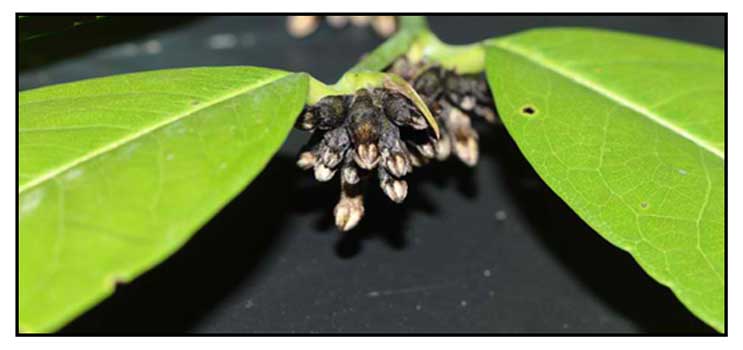
Family • Ebenaceae
Bolongeta
Diospyros pilosanthera Blanco
MACASAS EBONY
| Scientific names | Common names |
| Diospyros carthei Hiern | Alintautau (Tag.) |
| Diospyros cubica Bakh. | Amaga (Bik.) |
| Diospyros elmeri Merr. | Apopayot (Ibn.) |
| Diospyros helferi C.B.Clarke | Ata-ata (Bik.) |
| Diospyros hiernii Koord. | Atilma (Tag.) |
| Diospyros moonii Hiern | Baganito (Bik., S. L. Bis.) |
| Diospyros nidus-avis Kosterm. | Balatinau (Tag.) |
| Diospyros pilosanthera Blanco | Balingagta (Ibn., Ilk., Ig.) |
| Diospyros plicata Merr. | Balitinan (Ilk.) |
| Diospyros polyalthioides Hiern | Bantolinau (Bis., Tag.) |
| Diospyros rubescens Koord. & Valeton | Batolinau (Ibn.) |
| Diospyros tayabensis Merr. | Bolongeta (Ibn., Tag., Sbl.) |
| Dalondong (Bik.) | |
| Dambuhala (Tag.) | |
| Ditman (Klg.) | |
| Galorigar (Pang.) | |
| Katilma (Tag.) | |
| Mabolo-ti-bakir (Ilk.) | |
| Malapuyan (Tag.) | |
| Malatalang (Pang.) | |
| Marabikar (Bik.) | |
| Talang-gubat (Tag.) | |
| Tanaylan (P. Bis.) | |
| Black ebony (Engl.) | |
| Coromandel ebony (Engl.) | |
| Ebony tree (Engl.) | |
| Macassar ebony (Engl.) | |
| Diospyros pilosanthera Blanco is an accepted name. The Plant List | |
| Other vernacular names |
| FRENCH: Ebene macassar. |
| GERMANY: Ebenholz makassar. |
| INDIA: Tuki. |
| INDONESIAN: Kayu arang, Kayu hitam, Balun injuk, Semetik, Sora. |
| ITALIAN: Ebano di macassar. |
| MALASIA: Kumu, Kayu arang, Buey. |
| NETHERLANDS: Makassar ebben. |
| SRI LANKAN: Tendu, Ceylon ebony. |
| THAI: Kaling, Damdong, Nian. |
| VIETNAMESE: Thi nhum. |
Distribution Constituents Properties Parts used Availability |
Updated May 2019 / February 2017
![]()
 |
| IMAGE SOURCE: Type of Diospyros pilosanthera Blanco var. nurii Ng [family EBENACEAE] / Royal Botanic Gardens, Kew (K), K000792586 / JSTOR |
| IMAGE SOURCE: Photograph / Flowers / Diospyros pilosanthera / Loupok / Creative Commons Attribution-NonCommercial-ShareAlike 3.0 Unported License / click on image to go to source page / Useful Tropical Plants |
Additional
Sources and Suggested Readings |
| It is not uncommon for links on studies/sources to change. Copying and pasting the information on the search window or using the DOI (if available) will often redirect to the new link page. |
• |
 |
• |

 Gen info
Gen info Botany
Botany